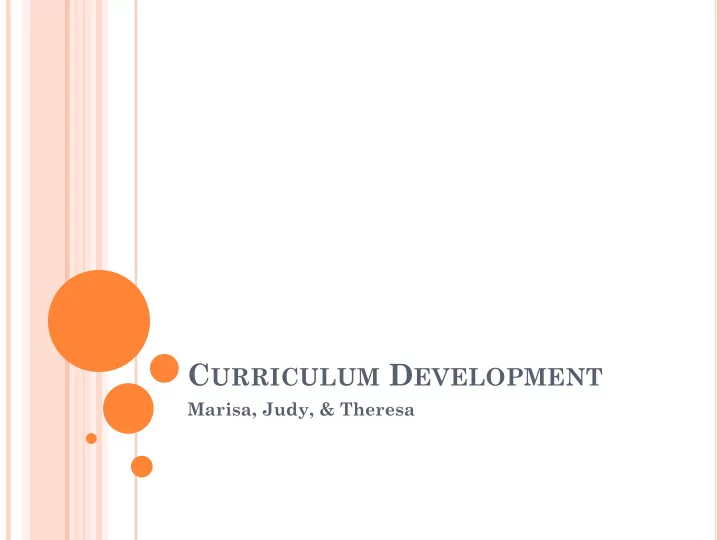

C URRICULUM D EVELOPMENT Marisa, Judy, & Theresa
K EY T OPICS 1. What should be the purpose of the curriculum? 2. What should be the content of the curriculum? 3. How should the curriculum be organized? 4. In what format should the curriculum be written? 5. At what level of curriculum development should teachers be involved?
P URPOSE OF THE C URRICULUM ¢ Transmission ¢ Transaction ¢ Transformation
C ONTENT OF THE C URRICULUM ¢ Sequence ¢ Continuity ¢ Scope ¢ Balance
BLOOM ’ S TAXONOMY Category Name Description Memory Students recall or recognize information Translation Student changes information into a different symbolic form or language Interpretation Student discovers relationships among facts, generalizations, definitions, values and skills. Application Student solves a life problem that requires the identification of the issue and the selection and use of appropriate generalizations and skills. Analysis Student solves a problem in the light of conscious knowledge of the parts and forms of thinking. Synthesis Student solves a problem that requires original creative thinking. Evaluation Student makes a judgment of good or bad, right or wrong, according to standards designated by student.
O RGANIZATION OF THE C URRICULUM ¢ Discipline Based ¢ Interdisciplinary Curriculum ¢ Transdisciplinary Curriculum
F ORMAT OF THE C URRICULUM ¢ Behavioral-objective format ¢ Webbing or conceptual mapping ¢ Results only
E XAMPLES OF THE 3 FORMATS Behavior Objective Format • Behavior Objective: • Activities: 1. Activity 2. Activity 3. Activity 4. Activity • Evaluation: Results-Only Format A. Objective 1. Result 2. Result 3. Result 4. Result B. Evaluation
TEACHERS ’ INVOLVEMENT IN CURRICULUM DEVELOPMENT ¢ Level 1 – Imitative Maintenance ¢ Level 2 – Meditative Maintenance ¢ Level 3 – Generative Maintenance
S TAFF C HARACTERISTICS Characteristics Low Moderate High Commitment to Low Would like to Eager to make Curriculum commitment make change change Change to change Level of thinking Low ability Can think of Has many about Curriculum to think think some suggestions about possible possible changes changes Expertise in Low Does not know Knows how to Curriculum expertise on how to write proceed Procedures how to curriculum proceed
C URRICULUM CHARACTERISTICS Low Moderate High Developers Outside Outside Internally developers developed but developed by substantially team of revised by a teachers with team of specialists as a teachers led by resource special Format Behavioral- Eclectic format Results only Objective; using behavior with suggested Highly objectives and activities structured webbing Development Imitative with To be mutually To be discussed allowance for adapted and changed minor revision continually
C URRICULUM & C ULTURAL D IVERSITY Level 4—The Social Action Approach—Students make decisions on important social issues and take actions to help solve them. Level 3—The Transformation Approach—The structure of the curriculum is changed to enable students to view concepts, issues, events, and themes from the perspectives of diverse ethnic and cultural groups. Level 2—the Additive Approach—content, concepts, themes, and perspectives are added to the curriculum without changing its structure. Level 1—the Contributions Approach—focuses on heroes, holidays , and discrete cultural elements.
G ROUP W ORK ¢ Split into 3 groups ¢ Create a Curriculum based on the topic of Iraqi War. Group 1 – Discipline based Group 2 – Interdisciplinary Group 3 – Transdisciplinary
D ISCIPLINE B ASED Objectives Activities Evaluation Students will demonstrate their understanding of the causes of the 1. Watch a Iraqi War documentary based on 9/11 2. Chart causes 3. Present and Discuss chart Assess charts and presentations
I NTERDISCIPLINARY • Political Leader Relationships History • Nuclear Weapons • UN Sanctions Geography Economics Iraqi • Control of the Oil • Guerilla Warfare • Effects on the American War • Desert Terrain Economy Culture Ethics • Genocide • Religion • Terroism • Women ’ s Rights
T RANSDISCIPLINARY ¢ What are possible resolutions of the Iraqi War Conflicts? Comparing & Contrasting American & Iraqi viewpoints Anticipate possible endings/making predictions Research to understand who, what, when, where, how, and why ¢ Utilizing the library, computers, etc.
S UMMARY --L OGICAL R ELATIONSHIPS OF C URRICULUM P URPOSE , C ONTENT , O RGANIZATION , & F ORMAT Curriculum Transmission Transaction Transformation Purpose: Curriculum Memory Interpretation Synthesis Content: Translation Application Evaluation Analysis Curriculum Discipline Based Interdisciplinary Transdisciplinary Organization: Curriculum Behavioral Webbing Results Only Format: Objective Philosophy: Essentialism Experimentalism Existentialism
R EFLECTION ¢ Curriculum planning and development when done as a team within a school, is a powerful instrument to enhance instruction and meet the standards. ¢ Imposing a curriculum on teachers will never be successful without the teachers ’ being able to have professional development and training in the area. ¢ Decisions about a good school, appropriate curriculum, and needs of students should be made by those closest to students.
B IBLIOGRAPHY ¢ Glickman, C. D., Gordon, S. P., & Ross-Gordon, J. M. (2007). SuperVision and instructional leadership: a developmental approach . Boston: Pearson Allyn & Bacon.
Recommend
More recommend